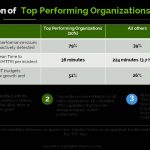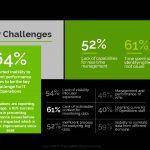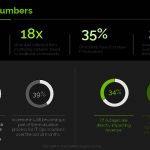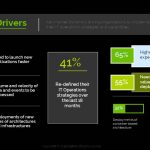Digital Enterprise Journal (DEJ) recently surveyed close to 900 end-user organizations for our benchmark study, The Roadmap to Becoming a Top Performing Organizations in Managing IT Operations, and thousands more in areas such as IT Transformation, Enabling Digital Workspace, Digital Transformation, IT Automation, DevOps, etc. This research shows that the role of IT Operations is significantly changing at a very fast pace. Based on this research, we identified 16 areas that are defining how the IT Operations market will look in the next 12-24 months.
0 – Ability to prove the business value. This area is in a category of its own. Sixty-one percent of organizations reported that they are looking to use technology to create competitive advantage, but 58% of business professionals reported their interest in learning more about technology features and functionalities as “low” or “very low”. Providers of IT Operations management solutions don’t have another choice other than to find a way to connect the dots between their value proposition and goals of business leaders, or many IT Operations functions will be taken over by DevOps, site reliability engineers (SREs) and other IT groups that can show a more direct business impact.
DEJ’s benchmark study shows a 39% increase in Line-of-Business (LoB) managers becoming a part of the evaluation process for IT Operations solutions over the last 18 months. The study also shows that the speed of application releases is the top driver for modernizing IT Operations (58% of organizations), while 36% reported that DevOps is taking a lead role in some traditional IT Operations tasks. There are many areas where IT Operations can make a very strong impact on desired business outcomes, but making this more visible and understandable for business leaders is the key for the future of this market.
1 – Cloud strategies. This is another area where IT Operations can prove strong value to the business. Organizations are placing the cloud in the core of their business strategies and using it as an instrument to create a competitive advantage. DEJ’s study, 17 Areas Shaping the IT Operations Market in 2018, showed that cloud management went from just another use case to a key requirement of IT Operations solutions. However, the study also showed that the performance of IT services in the Cloud is a completely different game from the management perspective. This year’s study shows that top performing organizations (top 20% of the survey participants based on performance) are 78% more likely to modify their strategy to meet specific requirements of monitoring Cloud and microservices. In an era where we are seeing an emergence of native cloud applications, organizations are understanding that they can’t address present issues with the tools that were built for IT environments of the past.
2 – Scalability vs. elasticity. The research shows that the amount of data that can be captured and processed is a significant differentiator between top performing organizations (TPOs) and all other organizations. Fourteen percent of TPOs reported scalability of management solutions as the key challenge for managing IT Operations, as compared to 76% for all others. Organizations have to be prepared to adjust to changes in their environments, which leads to adopting capabilities for their solutions to have the elasticity to easily scale up or down. DEJ’s benchmark study shows that TPOs are 84% more likely to be selecting monitoring solutions by predicting future amounts of data to be processed.
3 – User experience and customer-centric approach. DEJ’s research on digital experience monitoring (DEM) showed that the quality of user experience is the only true measure of IT performance in digital economy. DEJ’s survey on Enabling Digital Workspace shows that 53% of organizations see employee experience as a competitive differentiator. Additionally, organizations that are taking a customer-centric approach for managing IT operations are reporting that their level of customer engagement and ability to connect with customers via different channels improved by 64% and 81% respectively. However, one of the key elements of customer-centric IT is the ability to be proactive and prevent performance issues before users are impacted. Unfortunately, that is also the #1 challenge for managing IT Operations today (64% of organizations with only 6% improvement from the previous year).
To be able to leverage employee and customer experience as a source of competitive advantage, organizations need to deploy a set of capabilities that allow them to gain full visibility into how their digital services are truly performing from end-user perspective. In order to gain true visibility into what the level of user experience is, organizations have to be able to measure it as close to the end user as possible. The study shows that TPOs are 2.2x more likely to have the ability to monitor user experience at the point of interaction with application. The study also shows that TPOs are 59% more likely to be deploying testing processes that measure the impact on user experience.
4 – Dealing with change. What makes the job of IT Operations very challenging is the amount of change they are dealing with both 1)internally – tremendous amount of changes in environments they are managing and that is also accelerating every year; and 2) externally – changes in customer (both internal and external) expectations, usage patterns and technologies that they are adopting. DEJ’s study shows a 71% increase of revenue loss per 1 hour of downtime over the last 18 months and a 2.7x spike in the amount of alerts and events to be processed over the last 2 years. IT Operations job roles are traditionally not used to many changes in their everyday responsibilities and successfully dealing with this amount of change is not humanly possible without automating more processes and changing the skill set of IT staff. The study shows that TPOs are 52% more likely to educate their IT staff on AIOps related skills.
5 – True real time capabilities. Fifty-two percent of organizations reported a lack of capabilities for real-time management as the key challenge for IT Operations, which is a 41% increase since last year. Both TPOs and all other organizations have a good understanding about the benefits on relying on real-time data vs. puling historical data when needed. This is not a new concept and it has been adopted by many organizations. However, not all real-time data analysis is created equal. The speed of response and decision making is one of the key areas where IT operations can create a business value, therefore, it is important that organizations can have true visibility into both their performance and the business impact. The study shows that TPOs are 74% more likely to have capabilities for real-time analysis of streaming data.
6 – Platform approach. “Platform” is one of the favorite marketing terms in a digital economy, but deploying a true unified platform is one of the key requirements for effective management of IT Operations. The research shows that TPOs are 77% more likely to have capabilities for a unified analysis across an IT management stack. The study also shows that organizations who are taking a centralized, service-centric approach for IT performance management are able to manage 36% more users per IT FTE. However, organizations need to be able distinguish if the “platform” that a vendor is providing is a PowerPoint concept that connect all of their capabilities in one picture or a true unified solution that includes functionalities that are designed to work together.
7 – Data for all. One of the key ways for IT Operations to prove their value to the business. Organizations are estimating that only 11% of the IT data they are collecting is used to its full potential. That number would be even lower if organizations were aware of some of the use cases in which this data can be leveraged. The study shows that TPOs are 2.6x more likely to be ensuring that multiple job roles and departments gain value from IT data. These organizations understand the richness of the IT data and its value for the business. However, in order to maximize the value of the IT data, organizations need to put capabilities in place to unlock its full potential. TPO organizations are including this area in their business strategies, as the study shows they are 75% more likely to be taking an approach based on advanced analytics, automation and data and knowledge management concepts.
8 – AIOps and beyond. AIOps concepts cut across most of the key areas of TPOs practices. These organizations are 2.1x more likely to have an automated process for turning alerts into actionable events and 2.3x more likely to have capabilities for automated root cause analysis. However, the value of AI enabled solutions goes beyond IT Operations and it is increasingly being used in other areas of digital operations, such as DevOps, security operations, Continuous Delivery (CD) and Continuous Integration (CI). Organizations are increasingly understanding that AIOps is a concept, not a homogeneous class of technology or a competitive market. One of the key reasons why TPOs are more likely to be deploying AIOps capabilities is because they have more mature IT monitoring strategies and their data lakes are more complete. One of the key steps in a broader adoption of AIOps in the enterprise would be to provide monitoring and AIOps capabilities through the same platform. The study shows that organizations taking this approach are experiencing a 57% average reduction in operational cost.
9 – Machine learning and ease of use. Machine learning (ML) capabilities are playing a key role in enabling full visibility into IT environments, as TPO organizations are between 75% and 3x more likely to be using machine learning capabilities coupled with advanced analytics, such as anomaly detection. However, 30% of organizations reported the lack of technical expertise as the key obstacle for not deploying these solutions. Making ML based solutions easier to use is one of the keys for unlocking the potential of data and streamlining business processes, not only in the IT world, but also in the business world. The study shows a 39% average improvement in the ability to prevent performance issues by organizations that have the capability to leverage machine data without specific technical expertise required.
10 – Enabling API economy. Forty-six percent of organizations reported that management and performance of APIs is one of the key challenges for managing IT Operations. APIs are playing a critical role in digital economy and DEJ’s research shows that digital transformation leaders are 4.5x more likely to meet their integration goals. Enabling an API driven business model could be a major vehicle for IT Operations to take on more of a strategic role and prove its value to the business. TPOs are already understanding the importance of this, as the research shows they are 2.6x more likely to have a well defined API management strategy. These organizations are also investing in capabilities for ensuring a strong performance in this area, as they are 65% more likely to have the ability to monitor the impact of API performance on user experience.
11 – Enabling digital businesses. DEJ’s infographic shows 6 key attributes of leading organizations in meeting their digital transformation goals. These six areas are not only a major part of TPOs current strategies, but they should also be key pillars of modern IT Operations. Making a case that IT Operations can be one of the key enablers of digital transformation would go a long way for proving the value of these solutions to the business. Forward thinking organizations in managing IT performance are already well aligned with practices of digital transformation leaders and their example should be used as a guidance for the rest of the market when defining their role in enabling digital businesses.
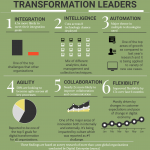
12 – Automation is just scratching the surface. Automation cuts across all of the key areas of managing IT Operations and 41% of organizations reported that automating IT Operations tasks is no longer optional, but its potential in this market is just scratching the surface. Organizations are mainly focusing on automating processes around incident management, root-cause analysis and remediation, however, there are still many areas where automation capabilities can make a major impact. The study shows that TPOs are 63% more likely to automate processes for launching new technologies and services. As a result, these organizations are reporting 5.1x faster new application releases as compared to all others.
13 – Beyond cost savings and productivity improvements. When communicating their value to the business, IT Operations teams are mostly focused on operational improvements such as cost savings and being able to “do more with less”. Even though these benefits are certainly appealing for the business, they still profile IT Operations as a cost center, just a more efficient one. The study shows that TPOs are 2.2x more likely to have customer experience as a central focal point of IT. As it was mentioned above, there is a strong alignment between key pillars of modern IT Operations and practices of digital businesses. Since that is the case, IT operations practices should focus on impacting key business outcomes of digital businesses – improving customer satisfaction and engagement, generating new revenue streams and advancing competitive position.
14 – Different aspects of context and insights. One of the key conclusions of DEJ’s 2018 IT Operations study was that context is king, as 71% of organizations reported that their IT performance data is not actionable. This year’s study shows that context of the data is still the king, but the definition of “context” has expanded beyond using the data to improve IT performance. Organizations are increasingly looking to put IT data in a context that would allow them to make better business decisions and leverage it in use cases that are not even IT related. The study shows that TPOs are 2.3x more likely to have enterprise wide initiative to evaluate technologies based on the ability to contribute to business outcomes. These organizations are putting the context of the data in the core of their business strategies and effective IT Operations practices are the key enabler of that approach.
X – Emergence of Digital Operations Management. This area is also in a different category. DEJ’s recent article, Transformation of the Market Formerly Known as “IT Operations”, revealed that if it doesn’t transform, “the term “IT Operations” will soon be used to describe just a use case, not a technology market focused on deployment, delivery and management of digital services that is centered around customer experience and driving business outcomes”. The research findings strongly supported that approach, as DEJ’s benchmark study shows that TPOs are 2.7x more likely (the highest ratio of 30+ TPO attributes that the study discovered) to leverage a single platform for IT, Dev, Security, IoT and Business Operations. That opens an opportunity for IT Operation Management to become a part of a broader market defined by : 1) focus on business outcomes; 2) customer centricity; 3) proactive and real-time approaches at scale; 4) advanced information, automation and data and knowledge management concepts; and 5) agility and shortest time to the market.


